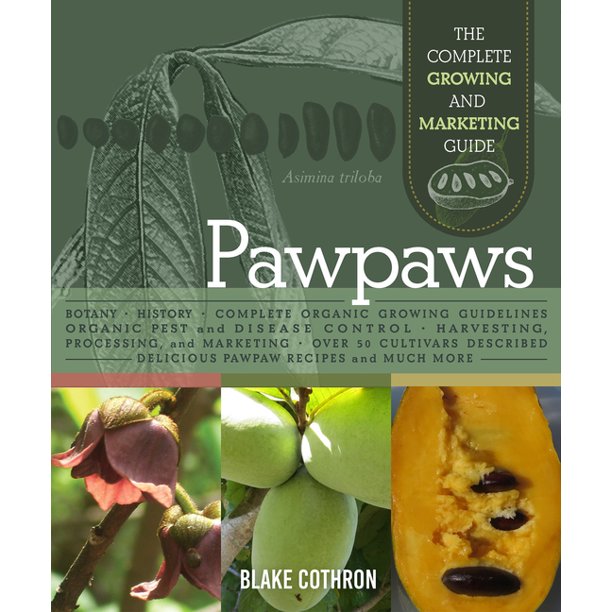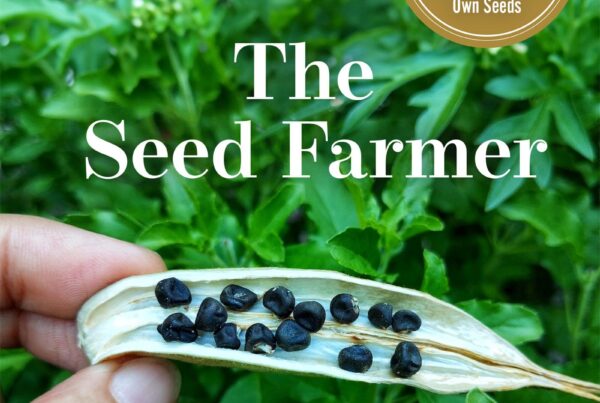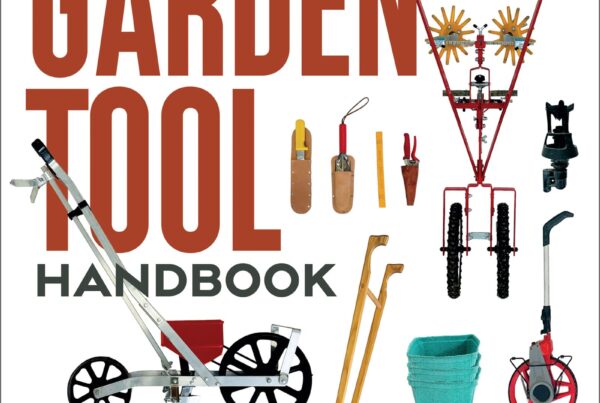| Â Pawpaws: The Complete Growing and Marketing Guide by Blake Cothron, New Society Publishers, 2021, $29.99
“Blake Cothron is an authority on pawpaws, and provides a clear, detailed guide for commercial success in growing this “oddly appealing species†(his own words). The supply of this exotic, trending, easy-to-grow fruit has not yet met the demand. Blake shares the wealth of his knowledge, including challenges, and when he doesn’t know, he says so (and it’s probable that others don’t know either.)†This is the advance praise I wrote for Pawpaws, now inside the front cover. Last fall I reviewed Michael Judd’s For the Love of Pawpaws, a permaculturist’s take on growing pawpaws among diversified crops. Blake’s book, while mainly intended for small-scale organic commercial growers, is equally useful for the backyard enthusiast. Blake ensures you have the information you need to choose what to grow, where to buy it, how to plant it, keep it thriving, prune and harvest. Depending on your scale, you can try the nine exquisite recipes here, or sell gourmet pawpaws online, or make value-added products such as craft brews, jams, and baked goods. Blake and his wife Rachel Cothron, own Peaceful Heritage Nursery, a 4-acre USDA Certified Organic research farm, orchard, and edible plant nursery, near Louisville, Kentucky, the perfect climate for pawpaws. America’s almost forgotten native fruit looks tropical and has an exotic appeal, but is an easy to grow temperate climate tree, and very cold hardy (US Winter hardiness zone 5, -20ËšF/-29ËšC). It is ripe for 4-6 weeks in late August-September. Although mostly grown in the South-east and Mid-Atlantic, pawpaws will grow in portions of 26 US states. Avoid confusion with the tropical papaya, which is sometimes also called pawpaw. The North American pawpaw is Asimina triloba. The book is studded with cultural gems such as that you can sometimes locate the site of an old native American village by the clusters of pawpaws still growing there. There are some false myths about pawpaws, including the idea that they are secretly tropical and related to bananas, papaya and mango, They are not. The second myth is that they grow best in shade. Also not true! They can grow in shade, but will not produce good fruit unless in full sun. A third myth is that they are ripe when blackened by frost. Oh no! They are usually ripe weeks before frost. Frost is not a benefit, but a cause of damage! (This myth is not true of persimmons either.) Another myth is that the flowers smell really bad. It’s just not true. Lastly, a myth that would be nice if true: pawpaws are not immune to all diseases and pests. Certainly they don’t suffer from as many health challenges as apples or peaches, but there are pawpaw troubles as Blake explains. All these stories show how important it is to have a trustworthy guidebook. Wild pawpaws are found as thickets of suckers growing up from the enmeshed roots of older trees, or as clusters of seedlings around a mother tree. They may feed wild animals, but will not grow the large tasty fruits humans want. Suckers are clones of the mother tree, and as pawpaws are rarely self-fertile, these thickets do not produce fruit. For human food, pawpaw trees need full sun, well-draining soil and plenty of space. Not what you might have assumed. Read this book! Wild pawpaws are most often found in moist lowland areas near water, but in well-draining areas, not swampland. They are often on sunny slopes (not northerly sides). They can be found along edges of clearings, trails and old roadways. In Kentucky, Blake reports about 25% of the wild pawpaws are tasty, 50% are edible and 25% are “spittersâ€. If you’ve experienced anything other than the top 25%, this book can be your encouragement to try some cultivated types. When you buy pawpaw trees, go for potted 1-4ft grafted trees at $30-$50 each. These will survive for 15-20 years and provide harvests for 10-15 of those. During that time you can plan where and when to plant your next pawpaw grove. Cheap bare-root seedling trees will save you money, but they won’t earn you money or appreciative friends. Premium fruit comes from premium trees, well cared-for. Pawpaw trees can mature at 20ft tall, or you can keep them pruned to be 7-15ft and avoid high ladder work. The diameter of a mature tree can be 20ft in full sun, with an attractive pyramid shape. When planning your orchard site, remember “the more sun, the more fruitâ€. 12-14 hours is best, but 7-8 hours of direct, strong, undiluted sunlight will be enough for a decent fruit set. Pawpaws are not too exacting about soil, apart from the need for good drainage. Soil can be improved, but heavy wet soils need improving years before planting! If you plan to mow with a tractor, you’ll need to plant rows 18-20ft apart. Otherwise 15-18ft between rows and 8-12ft between trees in the row will be enough. You do need genetically different trees close enough to cross-pollinate. There are three colors of fruit: yellow, orange and white, with the orange ones having the strongest flavors (“banana/honey/persimmon/pumpkinâ€). Yellow-fleshed cultivars have more of a “banana/cocoa butter/Mexican flan/nutty/marshmallow/caramel flavorâ€, very sweet, with an aroma of citrus, pineapple, cantaloupe and strawberry. The white-fleshed ones are the mildest, with a “vanilla/light banana/cantaloupe/coconut/tropical fruit†flavor and a high sugar content. Pawpaw fruit should be creamy, not watery or hard. There should not be any bitter or unpleasant after-taste! Another feature to consider when choosing varieties is the seed-to-pulp ratio. Ideally the seeds will comprise less than 10% of the total weight. Wild pawpaws can be 50% to 75% seeds. Blake includes 57 pages of good, bad and interesting facets of all 50 cultivars he could find in 2020. Some are widely available, others need to be tracked down through the North American Pawpaw Growers Association (NAPGA) or the North American Fruit Explorers (NAFEX). Don’t rely on nursery descriptions, but use Blake’s notes, where he has worked hard to be fair and objective. This book costs less than one tree, and can save many mistakes! Blake distinguishes between Early Ripening (Aug 20-Sept 5), Mid-Season (Sept 5-30) and Late Season (after Oct 1). The dates are for zones 5b-6b, and outside that area they offer a relative idea. There is a grading scale (incorporating different professional opinions) based on size, flavor, texture, reliability and yield. Choose As and Bs unless you have a good reason to do otherwise. Size grades are Jumbo (16oz+), Large (12-16oz), Medium (7-12oz) and Small (3-6oz). Commercial growers don’t mess with the little ones. A matter to face with pawpaws is that eating under-ripe ones can cause nausea. Some people cannot tolerate cooked pawpaw, Some speculate that it is the combination of cooked pawpaw with grains (as in baked goods) that give them trouble. Be ready for these possibilities but do not let them discourage you (or potential customers!) There are also people who sometimes experience mild euphoria after eating pawpaws, without harm. The one thing to never make or consume, is pawpaw fruit leather! It can cause 24 hours of serious intestinal distress. This is the “warts and all†part of the book. Avoid these problems and enjoy everything else about pawpaws. Thinking how to incorporate pawpaws into your diverse farming? You do need to keep the grass and weeds down somehow. Grazing, mowing or mulching are the usual methods. In damp eastern regions, mowing will need to be done once a month from April to October. Mulch needs to follow the 3:3:3 rule: 3ins deep, 3ft wide around each tree, keeping 3ins away from the trunk. Cardboard topped with organic mulch is one option. Landscape fabric is another. Wood or bark chips can work well. Blake tells cautionar Pawpaws go dormant in winter, unlike some other fruits that can be planted in the fall in milder climates. Plant in spring or early summer, digging large holes, breaking up the edges of the hole, supplying amendments, and having mulch on hand. This book gives clear step-by-step instructions. Staked tree protectors are essential for trees shorter than 30ins (seedlings) or 18ins (grafted trees). One main purpose is to protect the young trees from UV radiation. Tubex and Blue-X tree shelters are suggested. While the trees are young, you can use the aisles for something else, such as grazing, or growing hay or another crop. Whichever weed control method you use, you will need to hand weed the small inner circles around each tree, including clipping suckers coming up from the rootstock. This gives you an opportunity to study each tree up close and see how it’s doing. The pests and diseases chapter is complemented by color photos. With pawpaws, there is still much that is not known (or was known and then lost). Insects that attack pawpaws do not usually do much damage, although the list is long and includes borers, stinging caterpillars, a webworm, a leaf roller, the ubiquitous Japanese beetle, slugs, snails aphids, mites, thrips, scale insects and the Zebra Swallowtail Butterfly. Jeremy Lowe at VSU has a very good PowerPoint presentation with superb photos. I have been fascinated by the ZSB since reading about it in Michael Judd’s book, where I learned that the butterflies arrive at the time the pawpaws flower. Since then, I’m on the lookout each spring. The pawpaw is the ZSB’s only host, so do not kill all their caterpillars in your pawpaw trees – they have nowhere else to live! The eggs are laid between June and August. The caterpillars, which grow to 2ins long, eat the leaves and the damage to young trees is a real concern. Blake recommends hand-picking the caterpillars and carrying them to a wild pawpaw patch, or to some mature cultivated pawpaws, where they do little damage. Also, avoid destroying nearby wasp nests as the Ichneumon wasp Trogus pennator is a predator of the caterpillars, and nature may balance out. For many pests and diseases, the key to healthy trees is good sanitation, keeping a clean orchard floor (mulched or mowed, I don’t mean bare soil!), and removing diseased wood or leaves. Deer bite off buds and young shoots, and rub their antlers on the trunks. Goats do not eat pawpaw trees, although they can do damage rubbing their horns against the trunks. Other large pests include raccoons, possums, small rodents, and sapsuckers (small woodpeckers). Diseases include Phyllosticta leaf spot, a fungal pathogen., and a few others, including Black Spot (Diplocarpon spp) which strikes in rainy seasons. The condition of the leaves will show you if your fertility program is adequate. Healthy leaves are a deep vibrant green and bigger than human hands. Young trees should make 16-24ins of growth each year after the first one, until they are mature. Fertilize heavily from March-June in zone 6. The chapter on flowering stages and cold tolerance of each (information that is hard to find elsewhere) will save you from disappointment. See the helpful photos showing blossom stages. Unlike some tree fruits (apples, pears), pawpaws bloom over a period of time, resulting in flowers at different stages, giving insurance against all being killed by one frost. In zone 6 the very cold-hardy Velvet Bud stage, when fruit buds start to develop, is in mid-February and full bloom starts in early April. Pollination is conducted by various flies, beetles including lady bugs and ants, and spiders. Not by bees. So for good pollination, plant insect-attracting flowers in your orchard. Fruit takes 4-7 months to mature. Pawpaw trees begin to fruit in year 3-5, with 5-10lbs/tree and double that the next year. A mature tree will yield a bushel (30-40lbs). Harvesting needs to be done gently (no vigorous tree-shaking!). Use sharp bypass pruners and set the fruit in a single layer in cushioned boxes. Ship immediately or use refrigerated storage for a couple of days. If picked ripe but firm, pawpaws can be stored for 3-4 weeks under refrigeration. They won’t be as delicious as tree-ripened fruits. You can sell pawpaws at 2-3 times the price of apples, maybe $5-10/lb. Because the demand is not widespread, do not rely on farmers’ markets. The marketing chapter suggests 8 channels for selling pawpaw fruit. You will need to provide information and an attractive display or stunning photos if selling online. Avoid the question “What do we do now with a hundred or even thousands of pounds of soft, dripping ripe pawpaw fruit?†by planning months or years ahead. If selling remotely, make it really clear that pawpaws are only available to ship in August and September (or whatever is true in your region). Ship out only perfect unblemished fruit picked that same day, and ship only Monday-Thursday. Weekend shipping can go very wrong! Pack the fruit with enough lightweight packing material so that when you shake the box, nothing moves. (I learned this tip packing garlic for shipping.) Shipping fruit across the country is a strange business with a large carbon footprint. Consider if you have better options selling locally, including specialty groceries. Sales to restaurants can work well, as long as you have clear agreements, including price ($1-$3 per pound). Be perfectly reliable, make the chef’s life as easy as possible. Deliver early rather than late if you can’t be on time. One feature of modern pawpaw marketing is that currently most Americans prefer crunchy fruit (even crunchy peaches) and the pawpaw is far from crunchy. Describing the texture as similar to creamy avocados, but sweet, seems a promising approach. You could sell fruit as frozen pulp (deseeded!) to restaurants, bakeries or breweries. You could make value-added products from the less-than-perfect fruit yourself. As well as the items mentioned earlier, don’t overlook the possibilities of ice cream, chutney, food supplement pills and jewelry made form pawpaw seeds. Find out about the Cottage Food Laws in your state. Blake recommends the Ohio Pawpaw Growers Association with 29 handouts about NA Pawpaws. Aside from selling fruit, you could sell seeds, seedlings or grafted potted trees. Seedling trees can be unpredictable, but if you start with good parents, you improve the chance of getting good seedlings. You can use seedlings as rootstock for grafting, or sell them to people growing food forests where productivity is not the main concern. Seeds removed from ripe fruits need to be washed, cleaned, sterilized, labeled, stratified at 35-45ËšF for 90-120 days, ensuring they don’t freeze. Seeds are sown on their sides, and can take 6-12 weeks to emerge above the soil. 2-3 year-old seedlings are used for grafting rootstock. Grafting is fairly easy, and KSU has some very good free videos. The book includes a pawpaw calendar, cost analysis and some troubleshooting. Tips include not to worry if your new trees only grow a few inches the first year. This is probably because growth is happening underground, establishing strong roots. It could be a sign of root damage during transplanting, so if you are about to plant more, improve your technique! Damage caused by sunburn, dehydration, nutritional shortages, attacks by beetles, sapsuckers, string-trimmers, Phyllosticta disease, borers, deer, and winter sun, are all covered. The cost analysis deals with start-up costs (not minor when trees cost $30 each). For an acre containing 295 trees that’s $8,850. Tree protection fencing can add $1,376. Landscape fabric and irrigation together can equal the fencing cost. Other smaller costs add in to a total close to $10, 700 for the acre. Try for a wholesale tree price between $15 and $25, and your total is more like $6,260. Production costs are estimated by KSU at $1,650/acre; harvest and market costs at $6,200/acre, including labor for pruning and harvesting at $12.50/hr. Total variable costs come out at $8,400/acre. Gross returns could be $9,600/acre, if you sell wholesale at $1.75/pound. Don’t quit your day job yet, but pawpaws can be a good addition to an existing operation with compatible markets. The two-page Pawpaw Orchard Calendar is a quick reference guide for annual maintenance, and the dates where you live may need to be as much as one month later in spring and one month earlier in fall. The resources section includes books, supplies, and groups, including Peaceful Heritage Nursery. |
Blake has created a highly readable, enjoyable and very intensive exploration into the cultivation of North American pawpaw.†This book is practical, useful and fascinating.








